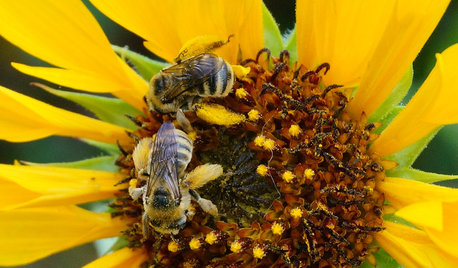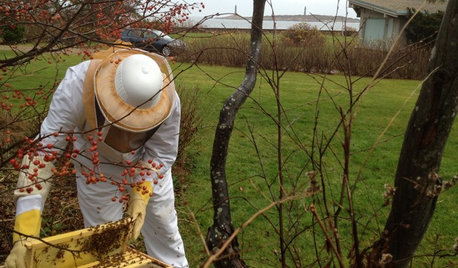could you be contributing to the great Bee die off?
joeinmo 6b-7a
10 years ago
Related Stories

EARTH DAY12 Entertaining ‘Bee-haviors’ of Native Bees
The parade of pollinator antics is another reason to create a garden that nurtures native bees
Full Story
LIFECould Techies Get a Floating Home Near California?
International companies would catch a big business break, and the apartments could be cool. But what are the odds of success? Weigh in here
Full Story
GARDENING GUIDESInvite Mining Bees to Your Garden by Planting Their Favorite Plants
Look for mining bees (Andrena) pollinating woodland wildflowers in U.S. gardens this spring
Full Story
GARDENING GUIDESAttract Hummingbirds and Bees With These Beautiful Summer Flowers
Roll out a welcome mat for pollinators to keep your landscape in balance and thriving
Full Story
GARDENING GUIDESPlant Black Cherry Trees for the Birds and Bees
Plant Prunus serotina in the Central and Eastern U.S. for spring flowers, interesting bark and beautiful fall color
Full Story
GARDENING FOR BUTTERFLIESGardening for the Bees, and Why It’s a Good Thing
When you discover how hard bees work for our food supply, you may never garden without them in mind again
Full Story
EARTH DAYHow to Design a Garden for Native Bees
Create a garden that not only looks beautiful but also nurtures native bees — and helps other wildlife in the process
Full Story
LIFESlow Living 101: Tips for Turning Off the Chaos
It may feel as though you're too busy to slow down and enjoy life. But even little changes can have a big effect
Full Story
LIFEYou Said It: ‘You Can Help Save the Bees’ and More Houzz Quotables
Design advice, inspiration and observations that struck a chord this week
Full Story
SMALL SPACESCould You Live in a Tiny House?
Here are 10 things to consider if you’re thinking of downsizing — way down
Full StoryMore Discussions









calliope
drrich2
Related Professionals
Bridgetown Landscape Architects & Landscape Designers · Roosevelt Landscape Architects & Landscape Designers · Saint Matthews Landscape Architects & Landscape Designers · Sand Springs Landscape Architects & Landscape Designers · Bridgeview Landscape Contractors · Middleton Landscape Contractors · Riverside Siding & Exteriors · West Elkridge Siding & Exteriors · Bonney Lake Decks, Patios & Outdoor Enclosures · Brookfield Decks, Patios & Outdoor Enclosures · Franconia Decks, Patios & Outdoor Enclosures · High Point Decks, Patios & Outdoor Enclosures · Owings Mills Decks, Patios & Outdoor Enclosures · Parlier Decks, Patios & Outdoor Enclosures · Rancho Palos Verdes Decks, Patios & Outdoor EnclosuresToronado3800 Zone 6 St Louis
Iris GW
Toronado3800 Zone 6 St Louis
drrich2
botann
hairmetal4ever
canadianplant
hairmetal4ever
Iris GW
saccharum
calliope
Iris GW
ken_adrian Adrian MI cold Z5
ricksample
Iris GW
calliope